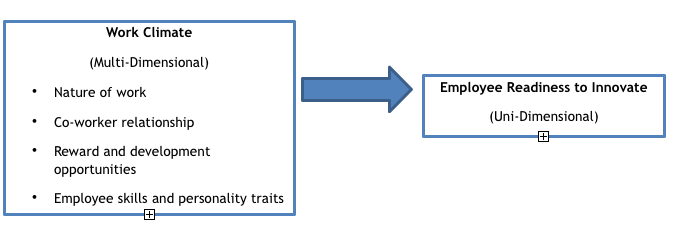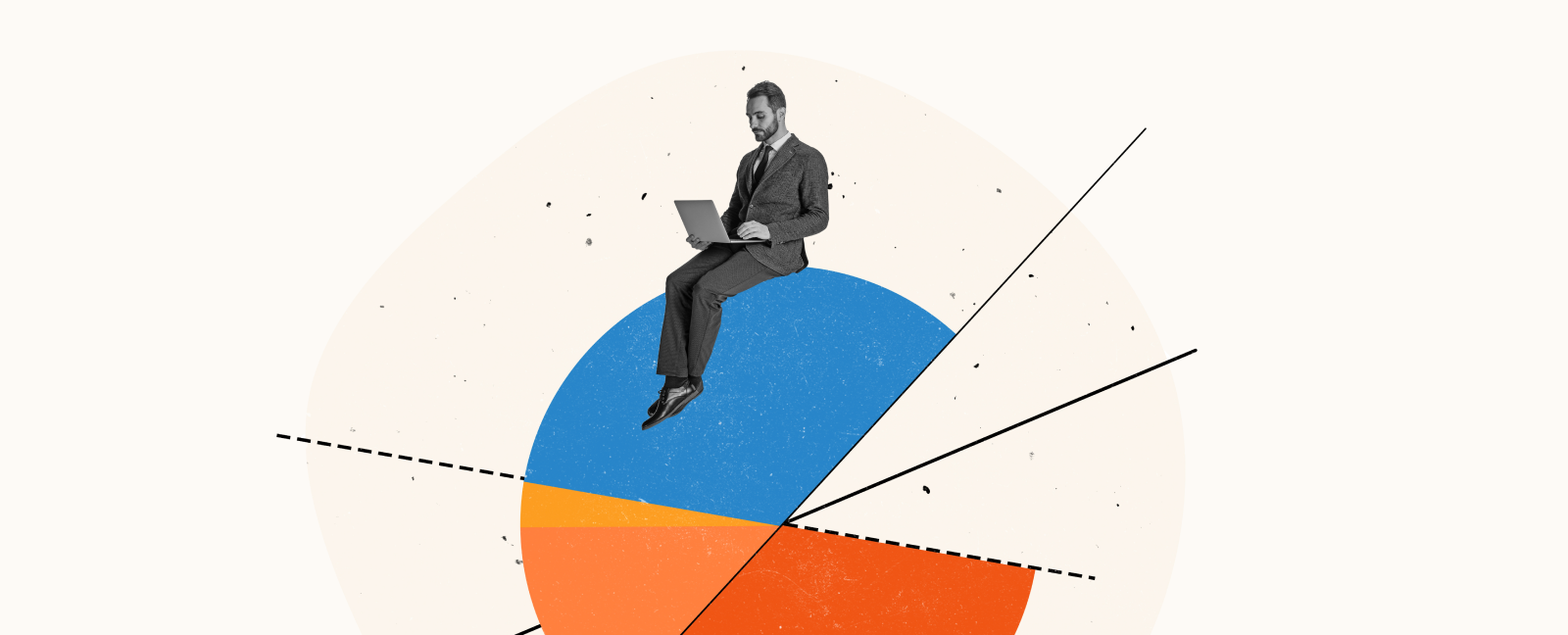The Dynamic Link between Workplace Climate and Employees' Readiness to Innovate: A Case Study on Meirc Training & Consulting

Introduction:
In addition to the technical and economic aspects of innovation, social dimension plays an important role in delivering successful innovation. Nowadays, a conductive and collaborative work climate is crucial to develop an innovative employee culture. Private organizations across the UAE are challenged by increased pressure to deliver innovation in order to survive within a highly competitive market and to cope with UAE 2021 strategy of setting UAE as one of the most innovative countries in the world. The multi-party setup of organizations requires adoption of an effective work climate that fosters introduction of a continuous stream of new ideas. This article focuses on the social aspect and soft determinants of innovation through examining the link between work climate and employee readiness to innovate in a private UAE-based organization; Meirc Training & Consulting.
In 2014, the UAE ministry cabinet established the “National Innovation Committee” to implement and follow-up on the UAE “National Innovation Strategy” which includes thirty national initiatives for driving innovation across the country. More recently, the Cabinet approved the naming of 2015 as the “Year of Innovation” and gave directions to all federal government entities to revise their policies in order to create an environment for innovation that leads U.A.E. to become among top countries in innovation. As declared by Sheikh Ahmed Bin Saeed (Dubai economic counsel, 2014), President of Dubai Civil Aviation and Chairman of Dubai Airports and Emirates Airline and Group, innovation will be the focus of “UAE Vision 2021” which should lead the country to turn into a knowledge-based economy rather than being an oil-based economy. He added; the above target would be accomplished through enhancing work climate that encourages creative initiatives and growth. Thus, UAE goal is to diffuse a culture of excellence and creativity that promote innovation in organizations. In response to this current gap, Dubai government adopted a proactive approach and launched three initiatives to foster innovation in the country. First initiative was the establishment of the “Mohammed Bin Rashid Centre for Government Innovation”. The second initiative was “Hamdan Innovation Incubator” to assist entrepreneurs in executing their new projects and create work climate that can influence innovation. The third initiative was the joint strategic initiative “spirit of innovation in Dubai”. These initiatives in adopting innovation made all UAE institutions across different sectors, both private and public enter a restless phase of joined effort to speed up the innovation process within their boundaries and across the country. Based on the above facts, Meirc also decided to analyze and assess work climates factors that are likely to influence its employees’ readiness for innovation.
Discussion:
Work climate-innovation relationship can stimulate the entrepreneurial spirit in its employees’ and drive their organization innovative capacity by creating a satisfactory work climate.
Meirc identified the below six factors to be directly and specifically targeting employee readiness for innovation:
Nature of work:
The nature of work represents the work in general (challenging or routine) and the updated tools used to perform the work. It includes different components such as: physical, social and structural components. These work components establish work demands and work resources. Employees tend to be more innovative if their work demands are challenging rather than getting involved in routine and trivial assignments. However, this relationship is affected by work challenge level and task clarity. In summary, employees will be innovative in responding to challenging work through changing their methods and approaches. In this respect, Meirc created challenging work descriptions for its employees.
Co-worker relationships:
Co-worker relationships refer to relationships among employees, departments, and management. These relationships could be based on rivalry or teamwork aspects. Meirc turned its organization structure from a mechanistic structure to organic/flat structure for encouraging innovation through enhancing informal communication and building co-workers relationship.
Rewards and development opportunities:
Rewards and development opportunities refer to the values and principles that employees recognize to be encouraged through the organization’s systems. Innovation can be improved through offering appropriate rewards systems where organizational values are mirrored in rewarded behaviors. Meirc designed a new system for rewarding individual creative behavior which resulted in enhancing the innovative attitude of all employees. Also, Meirc started offering personal development opportunities as well as professional growth which impacted innovation dramatically. Meirc also provided training opportunities for employees on creativity and innovation management.
Employee skills and personality traits:
Humans are the true assets of any organization. Thus, the skills and traits of employees can affect their innovation ability dramatically. Scholars identified many personality traits that can stimulate innovation such as: diverse interests, dynamism and persistence.
Meirc assisted its employees to enhance their skills (both technical and human skills) as well as their personal traits. Personal traits that can affect innovation are the employee being: knowledgeable, active, self-confident, comfortable with uncertainty, introvert and analytical thinker.
Employee involvement:
Employee involvement refers to their engagement in the decision making process in matters related to their responsibilities. Employee involvement and empowerment are direct factors that impact and sustain organizational innovation. Meirc empowered its employees to feel more motivated and self-confident in doing their jobs and thus show higher levels of innovation.
Supervisor support:
Supervisors need to provide structured systems and emotional support to their employees for encouraging innovation. In brief, supervisors need to walk the talk when they are encouraging innovation and not only offering “lip service”. Supervisory style is critical where innovation is built on leading and supervising employees towards change acceptance. Meirc supervisors and managers were coached on applying operating styles that shows flexibility in accepting ideas and suggestions from their employees. Open door policy was also encouraged to let employees come forward with their ideas and innovations. Finally, Meirc management supported employee innovation in different ways such as: allocating funds for their “pet projects”, changing policies, getting involved with employees during the innovation process and allowing brainstorming sessions for new ideas and products. Based on above-mentioned factors discussion; Meirc conducted a research that identified work climate as a global multidimensional independent variable with six work climate components: nature of work, co-worker relationships, rewards and development opportunities, employee skills and personality traits, employee involvement, and supervisor support. All the above-mentioned factors are likely to influence employee readiness to innovate as a uni-dimensional dependent variable. The research was done by employing random sampling method for primary data collection. The research instrument was a self-administered questionnaire submitted to Meirc employees’ at three different position levels: first, middle and lower levels. Ethical issues were taken into consideration while undergoing the research. For example, necessary approvals were taken prior to survey distribution; all participants were briefed on survey purpose and participant rights. Anonymity of participants was guaranteed and stated clearly in the questionnaire introduction. The questionnaire used a five-point Likert’s scale with the highest scale “strongly agree” and lowest scale “strongly disagree”. The questionnaire was composed of 42 item distributed over three sections; namely: demographic characteristics, work climate (both work and individual factors) and employee readiness to innovate. The instrument was designed to measure the six proposed factors of work climate multi-dimensional variable as well as the readiness to innovate as a uni-dimensional variable.

Figure 1. Research Conceptual Model
The findings of the research revealed that organizational work climate can be critical predictor of employees’ readiness to innovate. Highly significant links were found between employees’ readiness to innovate and work climate along with two of its components; namely employee skills and personality traits and nature of work. Other factors of work climate like employee involvement, supervisor, peer relations and reward and development factors also showed positive relationship with the employees’ readiness to innovate. Thus Meirc concluded that employees can develop their innovation readiness on the basis of work climate factors.
It is also recommended that managers create an environment that unleashes employee abilities to innovate. The way in which supervisors exercise management skills is also important and thus training programs for supervisors on communication and management skills will serve the goal of improving supervisor and peer relations and thus encouraging innovation.
Related Articles

Should HR Professionals Embrace AI Fully?
In the fast-changing tempo of businesses today, AI is no longer a thing…

A Workplace Counseling Tale
In the heart of Dubai, nestled amidst towering skyscrapers and the hum…

Building a Culture of Continuous Learning
During times of turmoil and when it comes to reduced corporate spending,…

People Analytics: Transforming Organizations Through Power of Data
Data is crucial in shaping business strategies and decision-making processes…
